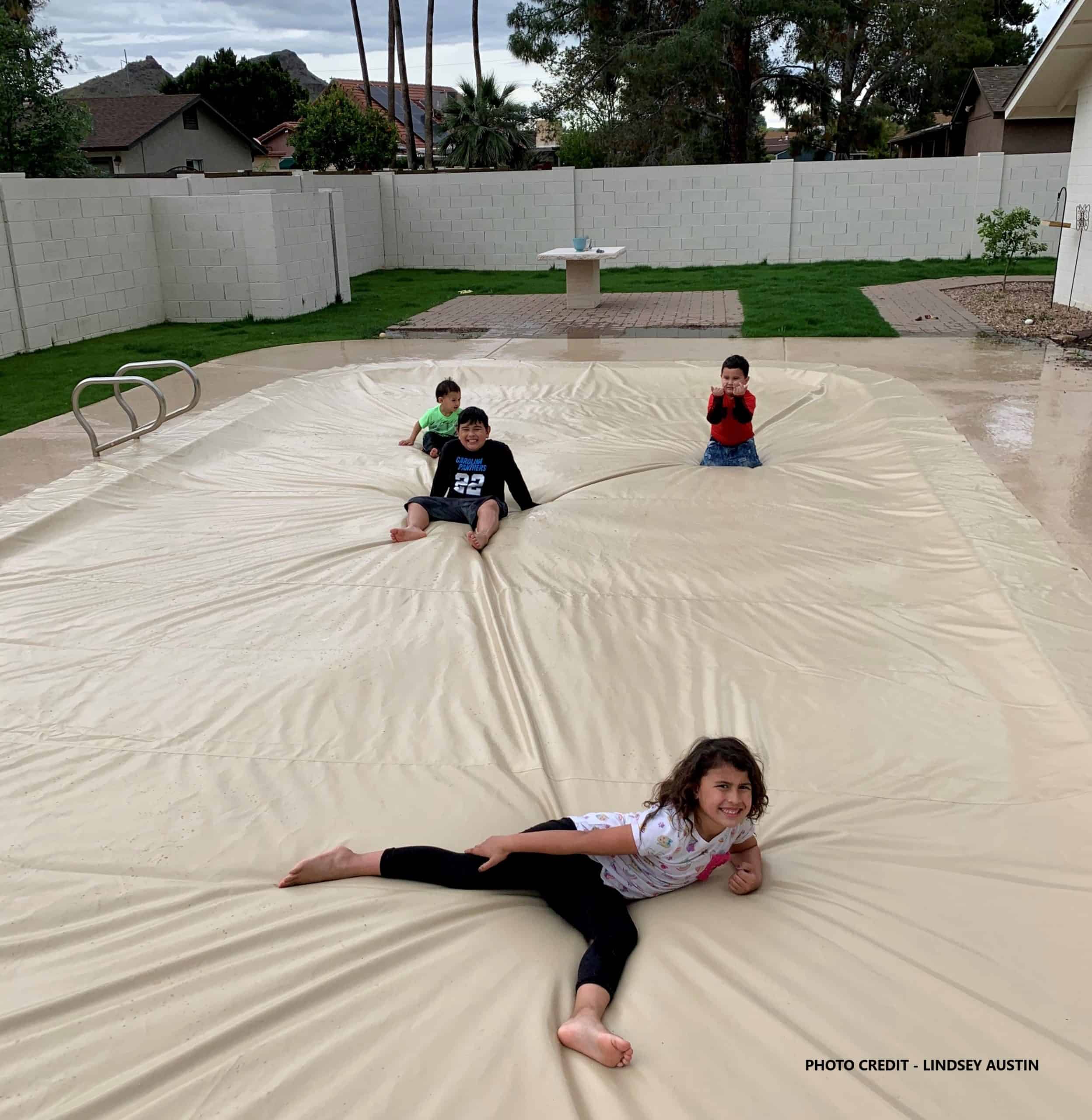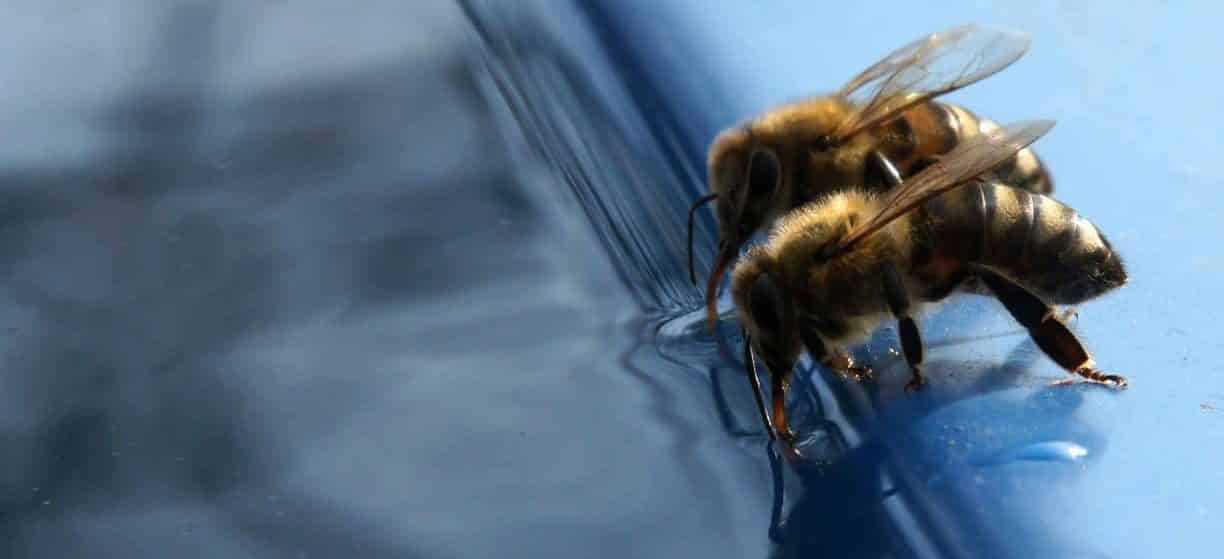UV stabilizers help slow down the wearing of plastic pool covers under the sun. But, too much sunlight, chlorine, and heat can still make your pool’s solar cover wear out quickly. It’s key to take good care of it to make it last longer. Here’s what you should do.
Key Takeaways:
- Shield your solar cover from direct sunlight and high temperatures when it’s not in use by utilizing UV protective over-covers.
- Maintain proper chemical balances in the pool to prevent damage to the solar cover.
- Clean your solar cover regularly with clean cold water and a soft brush to extend its lifespan.
- Store your solar cover in a cool, dark area to prevent it from becoming brittle.
- Remove the pool cover during super chlorination and winter months to avoid damage and debris accumulation.
Understanding the Basics of Solar Pool Covers
Solar pool covers are a smart choice. They use the sun’s energy to warm and protect pools. Their design is like bubble wrap. This design helps them heat the water and keep it warm.
These covers offer many pluses. They keep the water warm and stop it from disappearing. This not only saves on energy but also keeps the pool warmer longer. This way, people can swim longer without spending much more on energy. A good solar pool cover can work for 3 to 5 years. This is an affordable way to heat a pool.
They’re great at any time of year. On sunny days, they soak up the sun’s heat, warming the water. At night, they keep the warmth in, making swimming comfortable for longer. Solar pool covers also keep chemicals working well. This means fewer chemicals are needed.
You can find these covers in different thicknesses. They go from 8 mil to 16 mil. Each thickness holds in heat differently and comes with various warranties. The thinnest covers have a 3-year warranty. They can raise the water’s temperature by 10ºF. Thicker covers even offer an 8-year warranty and can increase the pool’s temperature by 18ºF.
These pool covers just float on top. They don’t need to be fixed to the sides. They’re easy to use and can save a lot on heating costs. That’s why they’re a top pick for anyone looking for energy-efficient pool covers.
How to Clean Pool Solar Cover?
Cleaning your pool’s solar cover is key to keeping it working well. Start by getting rid of any leaves or dirt. Use a hose to wash it, making sure all the dirt is gone.
Sometimes, you might need to scrub a bit harder on tough spots. Use a soft brush and a mild soap for this. Then, rinse the cover well. This stops algae and keeps everything clean.
It’s good to clean your solar cover every so often. This helps stop too much chlorine, algae, and mold from growing. Plus, it makes your cover last longer and work better.
Doing these easy cleanings and keeping regular care can make a big difference. Make sure the cover is dry and clean before putting it away. Store it in a shady, cool place for best results.
Proper Storage for Solar Pool Covers
Keeping your solar blanket in good shape starts with the right storage. First, make sure it’s clean and completely dry. Then, store it well to avoid any damage. Storing a cover that’s still wet can cause mildew. This not only smells bad but also ruins the cover’s material.
Follow these tips to make your solar cover last longer:
- Completely Dry – Dry the cover entirely on each side to stop mildew.
- Fold Uniformly – Use fan folding to make it easier to handle next time.
- Use a Container – Keep covers in sturdy boxes or containers with tight lids. This keeps moisture and pests out.
- Avoid Direct Sunlight – Choose a cool, shady spot for storage. Don’t let it be in the sun to prevent damage.
- Utilize Pool Cover Rollers – Using rollers is great. It protects your cover from the elements and makes it easy to deal with.
Don’t forget to keep your pool’s water balanced, too. This helps your solar cover last longer. With the right care and storage, your solar blanket will keep saving you money for many years. These steps help you store pool covers the right way, keeping them in good shape for use.
Maintaining Chemical Balance in the Pool
Keeping the chemical levels in the pool right is key to protecting your solar pool cover. You should aim for a chlorine level of 3 parts per million (ppm). Too much chlorine can harm the cover. If this happens, remove the cover until the chlorine evens out.
Run the pool pump when the sun is strongest. This helps spread the chlorine well. It stops chlorine from getting too high and hurting the solar cover. This step also helps keep the pool clean.
Bad chemical levels in the pool can ruin the cover. This is more likely with too much chlorine. Test and tweak the chemicals often to keep everything balanced. This way, your cover lasts longer.
Check the pool’s chemistry regularly to prevent too much chlorine. This can make the cover brittle. Managing your pool’s water well saves your money. It also helps your pool’s heater work its best.
How to Protect Your Pool Solar Cover from Sun Damage
Keeping UV protection for pool covers right is key. Use a UV-resistant cover when not using the solar cover. This keeps the sunlight from harming the pool cover’s material. Using this strategy can make your solar cover last longer.
Storing the solar cover well is also crucial. Keep it in a cool, shaded place. This stops the cover from getting too hot and the layers from sticking. A storage area with temperatures over 115F (45 degrees Celsius) could ruin the cover. So, a cool, dark spot is the best choice.
It’s also important to clean the solar cover often. Use clean cold water, a soft brush, and sometimes a safe cleaner. This helps remove dirt, mildew, and algae. These steps keep chlorine from staying on the cover, which can damage it.
- Make sure the cover is fully dry before putting it away to prevent damage.
- Light, clear solar covers are often easier to clean and manage than dark ones.
- Use only about 3 parts per million chlorine in the water to keep the cover safe.
Following these cover care tips regularly helps a lot. It slows down how fast your solar cover wears out. This means you can enjoy using your solar pool cover for a longer time.
How to Repair Minor Damages
Fixing small problems on a solar pool cover is easy and can make it last longer. It’s crucial to act fast if you see any tears or rips. These can get bigger quickly. A repair kit is a must-have for homeowners. Use it to patch up any damage. This helps keep the cover do its job well.
Check the cover for any damage every month. Finding problems early avoids big repairs later on. For small tears or holes, a patch from a kit can mend them quickly and effectively.
How you store and handle the cover is key to avoiding damage. Keep it out of the sun to prevent the material from breaking down. Using a solar reel makes managing the cover simpler. It helps prevent damage from tears or UV light. A solar tarp can also protect the cover when it’s not in use.
Storing the cover well is part of keeping it in good shape. Let it air dry and fold it neatly after every use. Buying a good solar cover and reel system can cut down on repairs. These tools are good at keeping the cover safely, reducing wear and tear.
Conclusion
Taking good care of your solar pool cover is really important. This guide shows you how to do it right. You need to clean it often, store it properly, keep the water chemistry good, and protect it from the sun. By doing this, your cover will last longer and work better. This means your pool will heat up well and save you energy.
When the sun is out, it’s best to keep your cover off. This way, the water heats up more evenly. But, if you leave it on, your pool’s protected from leaves and other debris. Too much sun, though, can harm your cover and make the water too hot in some spots.
It’s important to check your pool’s chemical balance too. This keeps the cover from getting ruined by chlorine or bromine. Experts say you should take the cover off once a week to keep it in good shape.
Finding the right storage spot is also key. Keep your cover somewhere dry and shady to avoid sun damage. Don’t forget to check it often and be gentle when you take it off. These steps will help your cover last longer. This way, you can heat your pool in an earth-friendly way and spend less on energy.






